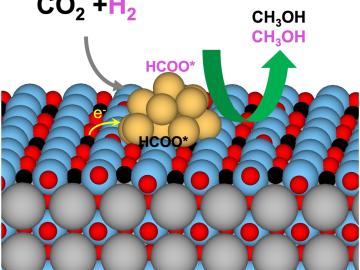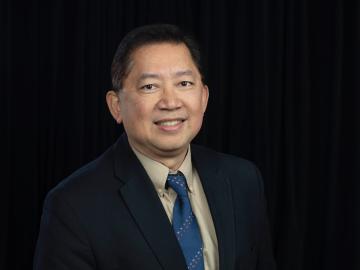Filter News
Area of Research
- Advanced Manufacturing (15)
- Biological Systems (15)
- Biology and Environment (86)
- Biology and Soft Matter (1)
- Building Technologies (3)
- Chemistry and Physics at Interfaces (5)
- Clean Energy (265)
- Climate and Environmental Systems (2)
- Computational Biology (4)
- Computational Engineering (2)
- Computer Science (6)
- Data (1)
- Electricity and Smart Grid (1)
- Energy Frontier Research Centers (8)
- Energy Sciences (3)
- Fossil Energy (2)
- Fuel Cycle Science and Technology (1)
- Functional Materials for Energy (9)
- Fusion and Fission (26)
- Fusion Energy (2)
- Geographic Information Science and Technology (2)
- Isotope Development and Production (2)
- Isotopes (19)
- Materials (259)
- Materials Characterization (2)
- Materials for Computing (13)
- Materials Synthesis from Atoms to Systems (6)
- Materials Under Extremes (6)
- National Security (41)
- Neutron Science (88)
- Nuclear Science and Technology (32)
- Nuclear Systems Modeling, Simulation and Validation (1)
- Nuclear Systems Technology (1)
- Quantum Condensed Matter (1)
- Quantum information Science (2)
- Reactor Technology (1)
- Renewable Energy (1)
- Sensors and Controls (2)
- Supercomputing (124)
- Transportation Systems (5)
News Type
Date
News Topics
- 3-D Printing/Advanced Manufacturing (61)
- Advanced Reactors (14)
- Artificial Intelligence (34)
- Big Data (16)
- Bioenergy (40)
- Biology (43)
- Biomedical (26)
- Biotechnology (10)
- Buildings (24)
- Chemical Sciences (40)
- Clean Water (7)
- Climate Change (38)
- Composites (12)
- Computer Science (73)
- Coronavirus (23)
- Critical Materials (12)
- Cybersecurity (24)
- Decarbonization (34)
- Education (3)
- Element Discovery (1)
- Energy Storage (58)
- Environment (80)
- Exascale Computing (14)
- Fossil Energy (1)
- Frontier (18)
- Fusion (21)
- Grid (24)
- High-Performance Computing (39)
- Hydropower (2)
- Irradiation (1)
- Isotopes (27)
- ITER (3)
- Machine Learning (18)
- Materials (75)
- Materials Science (66)
- Mathematics (3)
- Mercury (6)
- Microscopy (27)
- Molten Salt (2)
- Nanotechnology (34)
- National Security (35)
- Net Zero (5)
- Neutron Science (64)
- Nuclear Energy (46)
- Partnerships (27)
- Physics (40)
- Polymers (18)
- Quantum Computing (11)
- Quantum Science (30)
- Renewable Energy (1)
- Security (17)
- Simulation (15)
- Software (1)
- Space Exploration (3)
- Statistics (2)
- Summit (23)
- Sustainable Energy (48)
- Transformational Challenge Reactor (4)
- Transportation (41)
Media Contacts

Vanderbilt University and ORNL announced a partnership to develop training, testing and evaluation methods that will accelerate the Department of Defense’s adoption of AI-based systems in operational environments.

Robert Wagner, associate laboratory director for ORNL's Energy Science and Technology Directorate, has been selected to receive the George Westinghouse Gold Medal from the American Society of Mechanical Engineers, or ASME. The award recognizes his work to advance state-of-the-art clean power generation systems through research on combustion, fuel technologies and controls.

Scientists have uncovered the properties of a rare earth element that was first discovered 80 years ago at the very same laboratory, opening a new pathway for the exploration of elements critical in modern technology, from medicine to space travel.

A team of scientists led by ORNL found an unconventional way to improve catalysts made of more than one material. The solution demonstrates a path to designing catalysts with greater activity, selectivity and stability.

Researchers at ORNL are developing battery technologies to fight climate change in two ways, by expanding the use of renewable energy and capturing airborne carbon dioxide.

ORNL researchers have produced the most comprehensive power outage dataset ever compiled for the United States. This dataset, showing electricity outages from 2014-22 in the 50 U.S. states, Washington D.C. and Puerto Rico, details outages at 15-minute intervals for up to 92% of customers for the eight-year period.

Joseph Chapman, a research scientist in quantum communications at ORNL, was given the Physical Review Applied Reviewer Excellence 2024 award for his work as a peer reviewer for the journal Physical Review Applied.

Mohamad Zineddin hopes to establish an interdisciplinary center of excellence for nuclear security at ORNL, combining critical infrastructure assessment and protection, risk mitigation, leadership in nuclear security, education and training, nuclear security culture and resilience strategies and techniques.

Howard Wilson explores how to accelerate the delivery of fusion energy as Fusion Pilot Plant R&D lead at ORNL. Wilson envisions a fusion hub with ORNL at the center, bringing together the lab's unique expertise and capabilities with domestic and international partnerships to realize the potential of fusion energy.

Rigoberto “Gobet” Advincula, a leader in advanced materials, polymers and nanomaterials with joint appointments at ORNL and the University of Tennessee, has been named to the U.S. National Academies of Sciences, Engineering and Medicine’s Board on Chemical Sciences and Technology.




